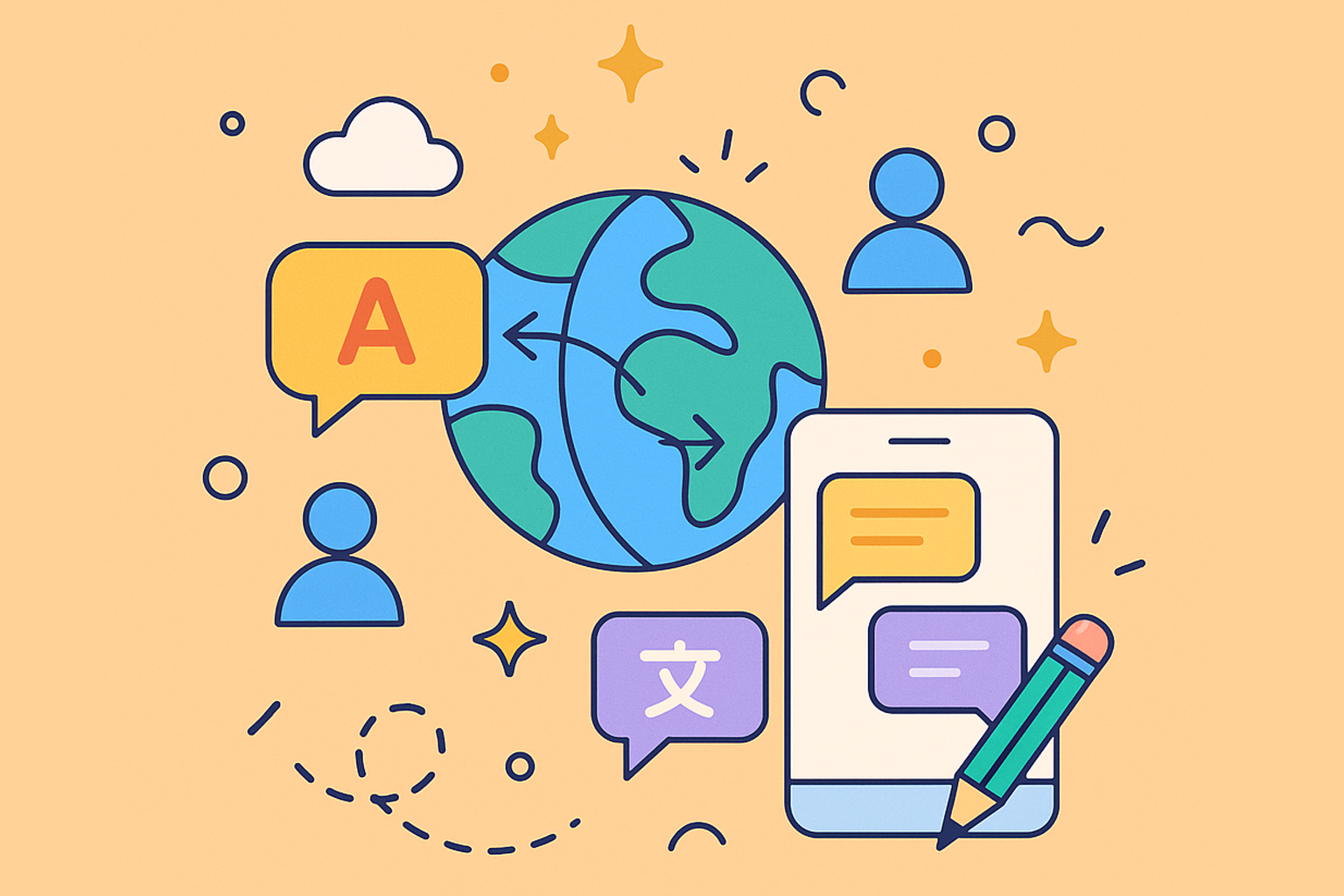In our increasingly connected world, language should be a bridge, not a barrier. Whether you’re a globetrotter navigating a new city, an e-commerce brand serving international customers, or a project manager coordinating with global teams, instant and accurate translation is no longer a luxury, it’s essential. The right app for language translation can transform confusing interactions into clear, meaningful conversations and streamline cross-border operations.
But with a sea of options available, each promising seamless communication, how do you choose the one that truly fits your specific needs? This guide cuts through the noise. We have curated a definitive list of the top translation tools, evaluating each on accuracy, unique features, real-world use cases, and overall value. From simple text translation for travelers to sophisticated, integrated solutions for enterprise service desks, we provide the insights you need to make an informed decision.
This comprehensive resource is designed to help you find the perfect tool to unlock a world without language barriers. Each entry includes a detailed analysis, honest limitations, and direct links so you can get started immediately. Let’s dive in and identify the best solution to solve your communication challenges.
1. resolution Reichert Network Solutions GmbH
For businesses operating within the Atlassian ecosystem, Resolution’s Issue Translation for JSM stands out as a powerful and deeply integrated app for language translation. It is specifically engineered to dismantle language barriers within Jira Service Management, transforming your service desk into a truly global support hub. This tool empowers IT and service teams to communicate with customers in their native languages, directly within their existing workflows.
Unlike general-purpose translation apps, this solution offers enterprise-grade security and is designed for scalability. It was named the official Atlassian ITSM App Partner of the Year, a testament to its seamless integration and robust performance in high-stakes environments.
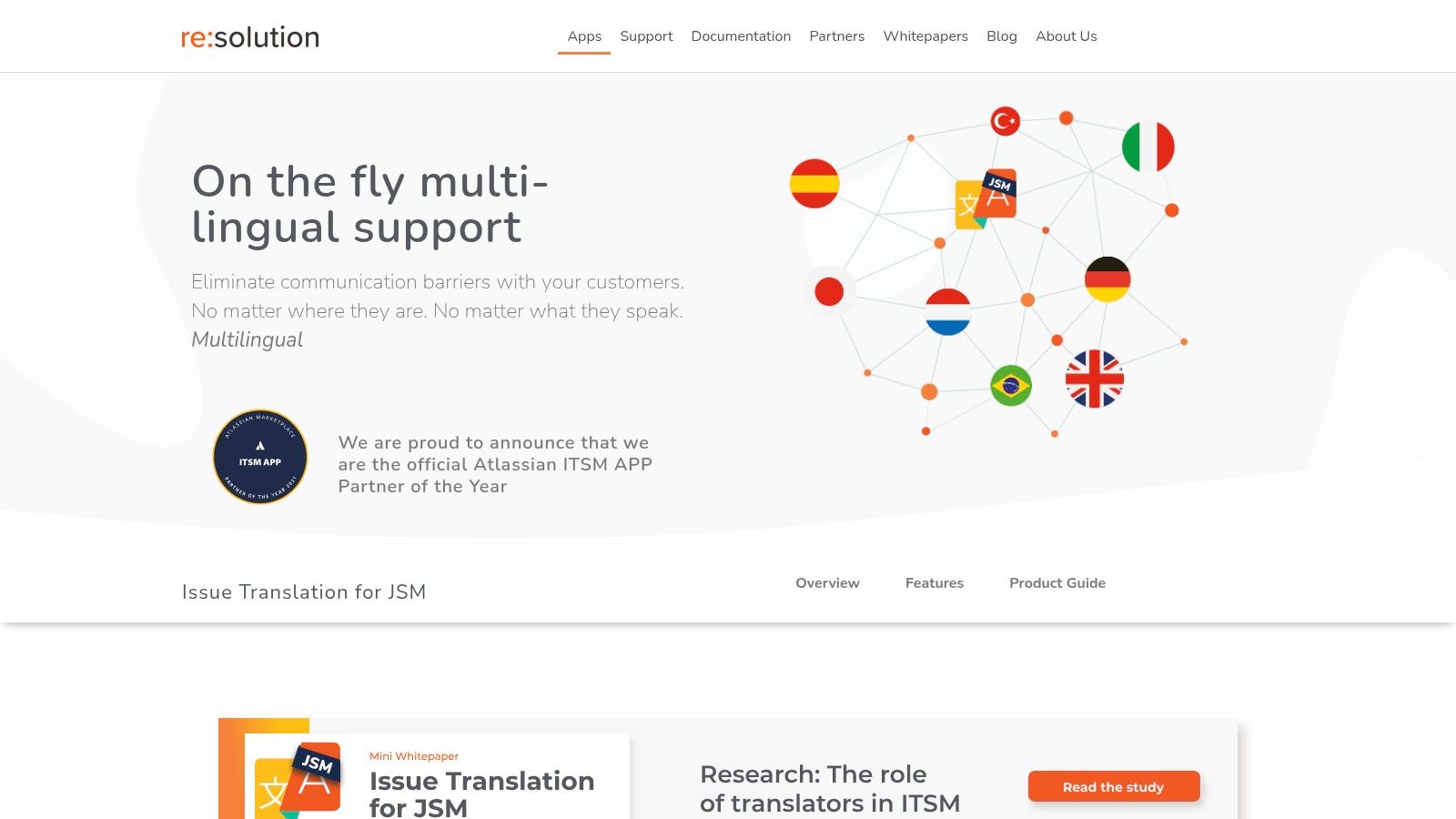
Key Features and Use Cases
The app’s real strength lies in its specialized features that cater directly to service desk operations. The AI-powered, real-time translation engine works behind the scenes, allowing agents to handle tickets from any region without needing to switch platforms or hire multilingual staff.
- Bilingual Mode: This mode displays both the original customer message and the translation, providing full transparency. This is ideal for quality assurance or when agents need context to ensure the nuances of a technical issue are perfectly understood.
- Invisible Mode: For a frictionless customer experience, this mode presents all communications in the end user’s native language, making the interaction feel seamless and personalized.
- Workflow Integration: It integrates with canned responses and can be connected to Slack via JSM Chat. This allows agents to use pre-approved, translated answers for common queries, significantly speeding up response times.
- Advanced Ticket Management: Teams can create language-based queues to automatically route tickets to native speakers if available. You can also use advanced JQL searches to analyze ticket trends by language, helping to identify regional support needs.
Practical Tip: Use the built-in translation editor to refine key automated messages or canned responses. This allows you to maintain brand voice and ensure absolute accuracy for critical customer-facing communication.
Analysis and Verdict
| Feature | Assessment |
|---|---|
| Primary Use Case | Eliminating language barriers in Jira Service Management for global IT support. |
| Integration Quality | Excellent; deep integration with Jira, Slack, and other Atlassian tools. |
| User Experience | Streamlined for agents, with flexible modes to suit different team preferences. |
| Pricing Model | Affordable subscription model available on the Atlassian Marketplace. |
Pros:
- AI-powered, real-time translation embedded directly in Jira.
- Two flexible translation modes (Bilingual and Invisible).
- Supports language-based queues and advanced JQL analysis.
- Enterprise-grade security trusted by major global brands like Disney and IBM.
Cons:
- Exclusively for Jira Service Management users; not a standalone app.
- AI translations may need human review for highly technical or sensitive content.
Ultimately, Issue Translation for JSM is not just a translation utility; it is a strategic tool for any organization looking to scale its support operations globally without the overhead of a multilingual team. It boosts customer satisfaction and operational efficiency, making it an indispensable app for language translation for teams on the Atlassian platform.
Website: https://www.resolution.de/issue-translation-for-jsm
2. Google Translate
Google Translate is arguably the most recognized and accessible app for language translation on the market. Its ubiquity is its greatest strength, offering a reliable, no-cost solution for instant text, voice, and even image-based translations directly from a smartphone camera. For travelers and casual users, its real-time conversation mode and the ability to download language packs for offline use are indispensable features.
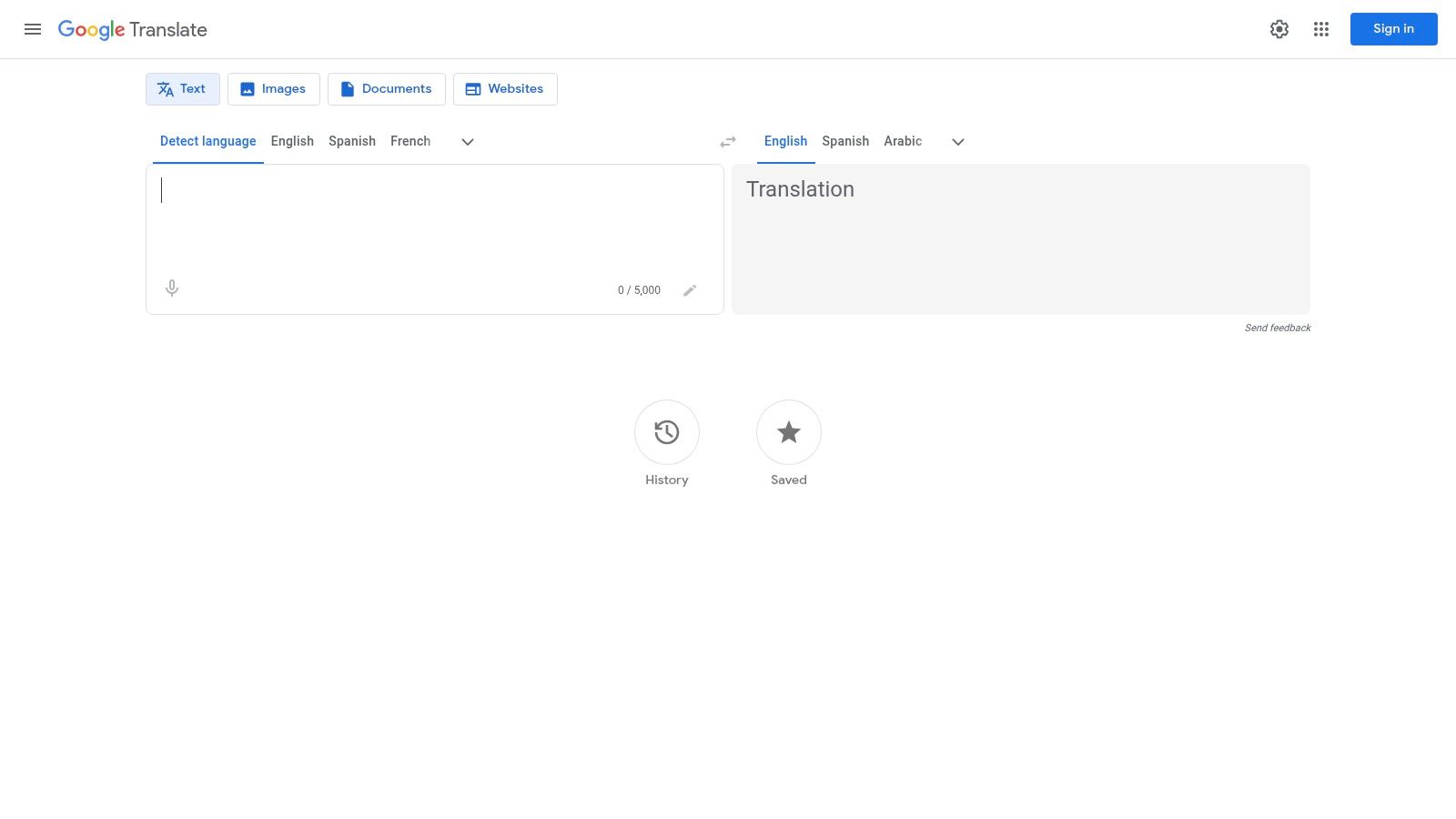
The platform stands out due to its deep integration within the Google ecosystem, appearing in search results, Chrome, and G-Suite apps. While its machine learning algorithms have improved dramatically, it’s best suited for straightforward communication rather than nuanced or technical business documents. The user interface is clean and intuitive, requiring virtually no learning curve to start translating. For organizations needing more robust solutions, it’s worth exploring how Google’s translation capabilities integrate within a broader translation management system.
Key Considerations
| Feature | Analysis |
|---|---|
| Best For | Quick, on-the-go translations, travel, and casual use. |
| Pricing | Completely free for consumer use. |
| Pros | Massive language support, versatile input methods (text, voice, image), and offline functionality. |
| Cons | Can struggle with context, idioms, and complex sentence structures, leading to inaccuracies. |
Website: https://translate.google.com
3. Microsoft Translator
Microsoft Translator is a formidable app for language translation, rivaling its main competitors with a powerful suite of features for both personal and professional settings. It excels in real-time, multi-person conversations, allowing users to connect their devices and see translated text in their chosen language. This functionality is a game-changer for international business meetings or multicultural group travels, offering a seamless communication bridge across different languages.
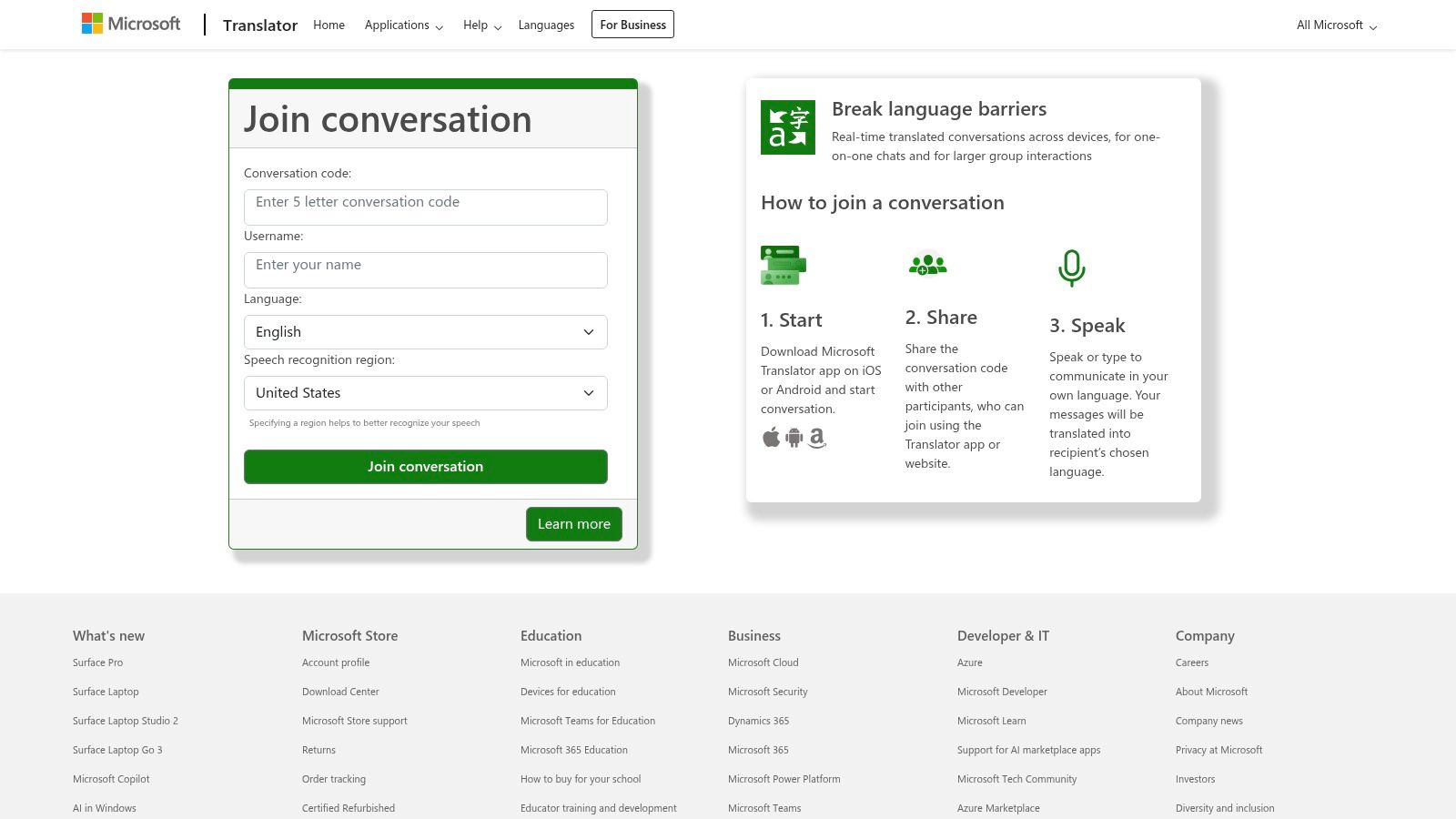
The platform’s key differentiator is its deep integration within the Microsoft ecosystem. Users can translate documents directly in Word, presentations in PowerPoint, and messages in Teams, streamlining workflows for global organizations. The user interface is clean and intuitive, making its advanced features accessible. While it offers robust offline packs and solid translation quality, some advanced collaboration features necessitate a Microsoft account, and its language library, while extensive, is not as vast as some alternatives.
Key Considerations
| Feature | Analysis |
|---|---|
| Best For | Business users, multi-person conversations, and integration with Microsoft Office. |
| Pricing | Free for personal use. Business use is priced via Azure Cognitive Services. |
| Pros | Excellent for group conversations, seamless Microsoft product integration, and a user-friendly interface. |
| Cons | Fewer languages supported than competitors; some features require a Microsoft account. |
Website: https://translator.microsoft.com
4. DeepL Translator
DeepL has earned a reputation as a superior app for language translation, often producing results that are more nuanced and natural-sounding than its competitors. Powered by advanced neural network technology, it excels in capturing the context and subtleties of language, making it a preferred choice for professional and business communications where accuracy is paramount. Its ability to translate entire documents while preserving the original formatting is a significant advantage for corporate users.
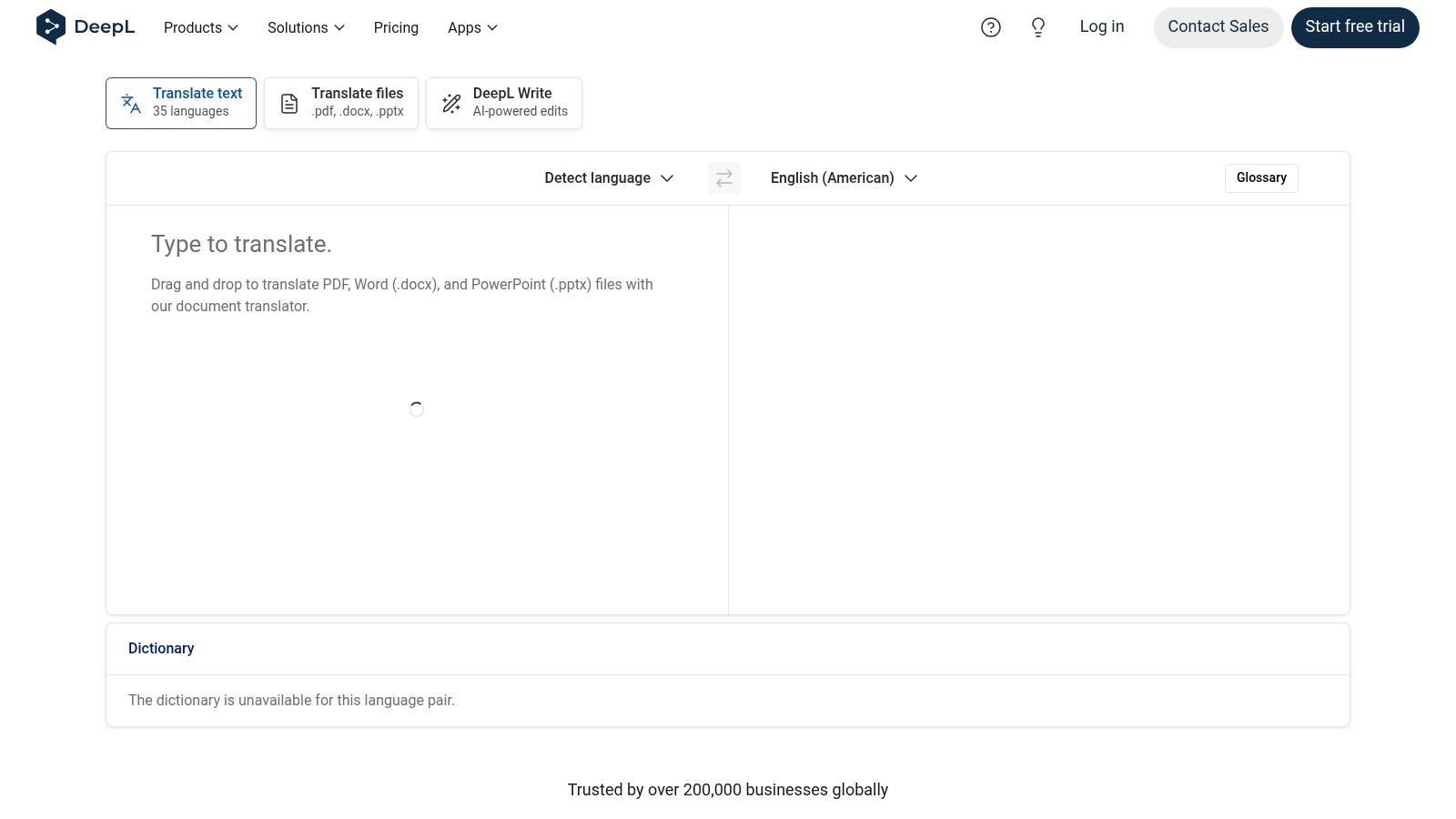
The platform’s key differentiator is its quality, especially with European languages. The user interface is clean and minimalist, focusing purely on delivering high-fidelity translations. While the free version is robust, the premium plans unlock features like unlimited text translation, enhanced security, and the ability to choose between formal and informal tones. This level of control is crucial for projects where tone consistency is part of a broader language localization strategy.
Key Considerations
| Feature | Analysis |
|---|---|
| Best For | Professional-quality translations, business documents, and users prioritizing accuracy over language variety. |
| Pricing | Free version with limits; Paid plans (Pro) for advanced features and higher usage. |
| Pros | Exceptionally high translation accuracy, preserves document formatting, and offers tone adjustment options. |
| Cons | Fewer supported languages compared to major competitors; the most powerful features are behind a paywall. |
Website: https://www.deepl.com/translator
5. iTranslate
iTranslate is a highly popular and mobile-friendly app for language translation that excels in user experience, especially for travelers. It offers a comprehensive suite of features, including text, voice-to-voice conversations, and camera-based translations, supporting over 100 languages. Its design prioritizes ease of use, making it a strong contender for those who need quick and reliable translations on the go without a steep learning curve.
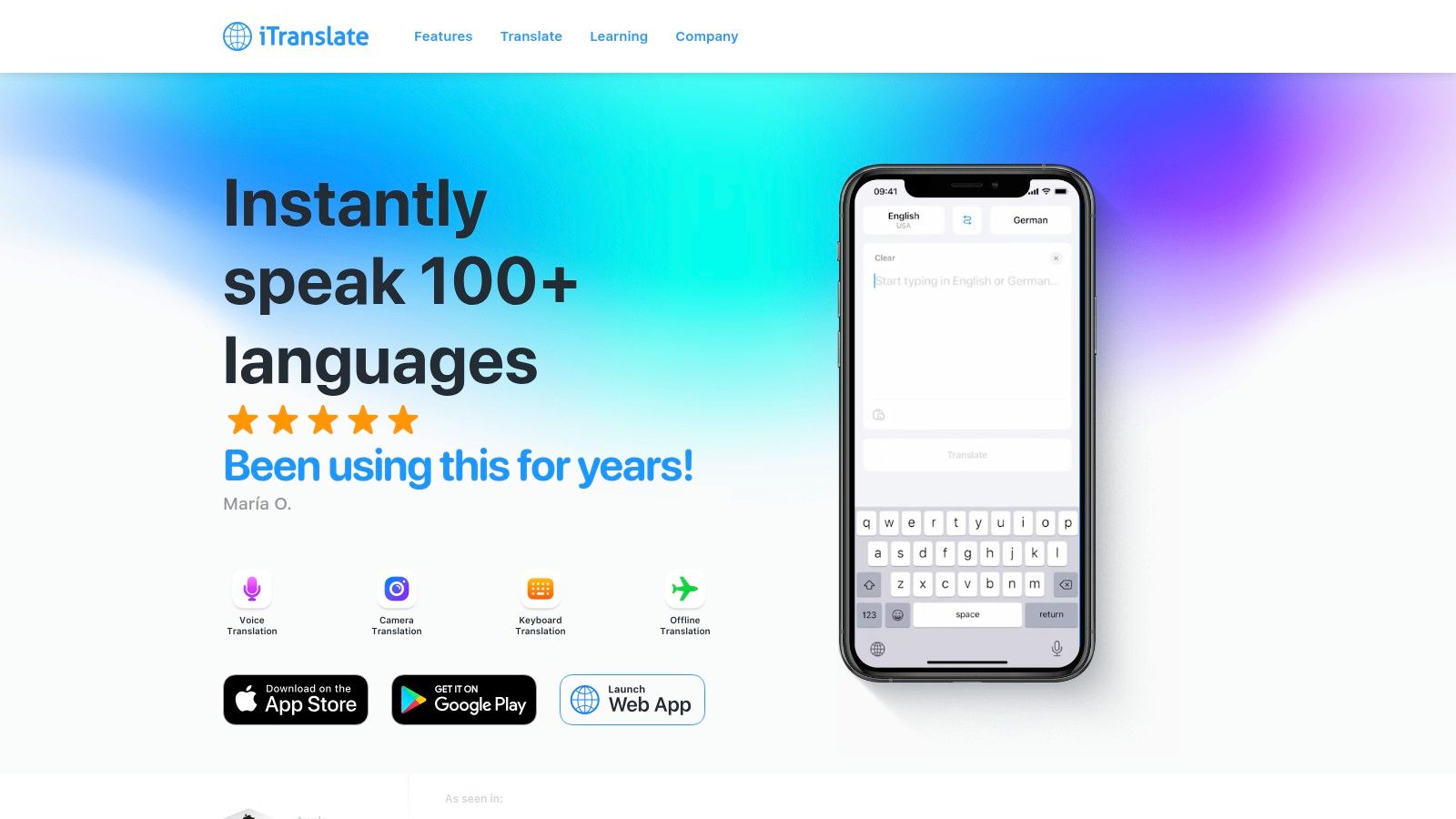
The platform distinguishes itself with a clean and intuitive interface that makes navigating its features seamless. While the free version is functional, the real power of iTranslate is unlocked with its Pro subscription, which adds offline mode for select languages, website translation, and verb conjugations. This freemium model allows users to test the basic functionality before committing. To see how it compares to other solutions, you can explore this overview of language translation apps.
Key Considerations
| Feature | Analysis |
|---|---|
| Best For | Travelers, students, and users seeking a user-friendly mobile experience with advanced features. |
| Pricing | Freemium model; a Pro subscription is required for offline mode and all features. |
| Pros | Sleek and intuitive interface, broad language support, and powerful voice-to-voice conversation mode. |
| Cons | The most essential features are behind a paywall, and like other tools, it can have occasional inaccuracies with complex phrases. |
Website: https://www.itranslate.com
6. Reverso
Reverso differentiates itself from other apps for language translation by focusing heavily on context and language learning. Instead of merely providing a direct translation, it uses its vast bilingual corpus to show words and phrases used in authentic sentences, helping users understand nuance, idiomatic expressions, and appropriate usage. This makes it an invaluable tool not just for translation but for actively improving language proficiency.
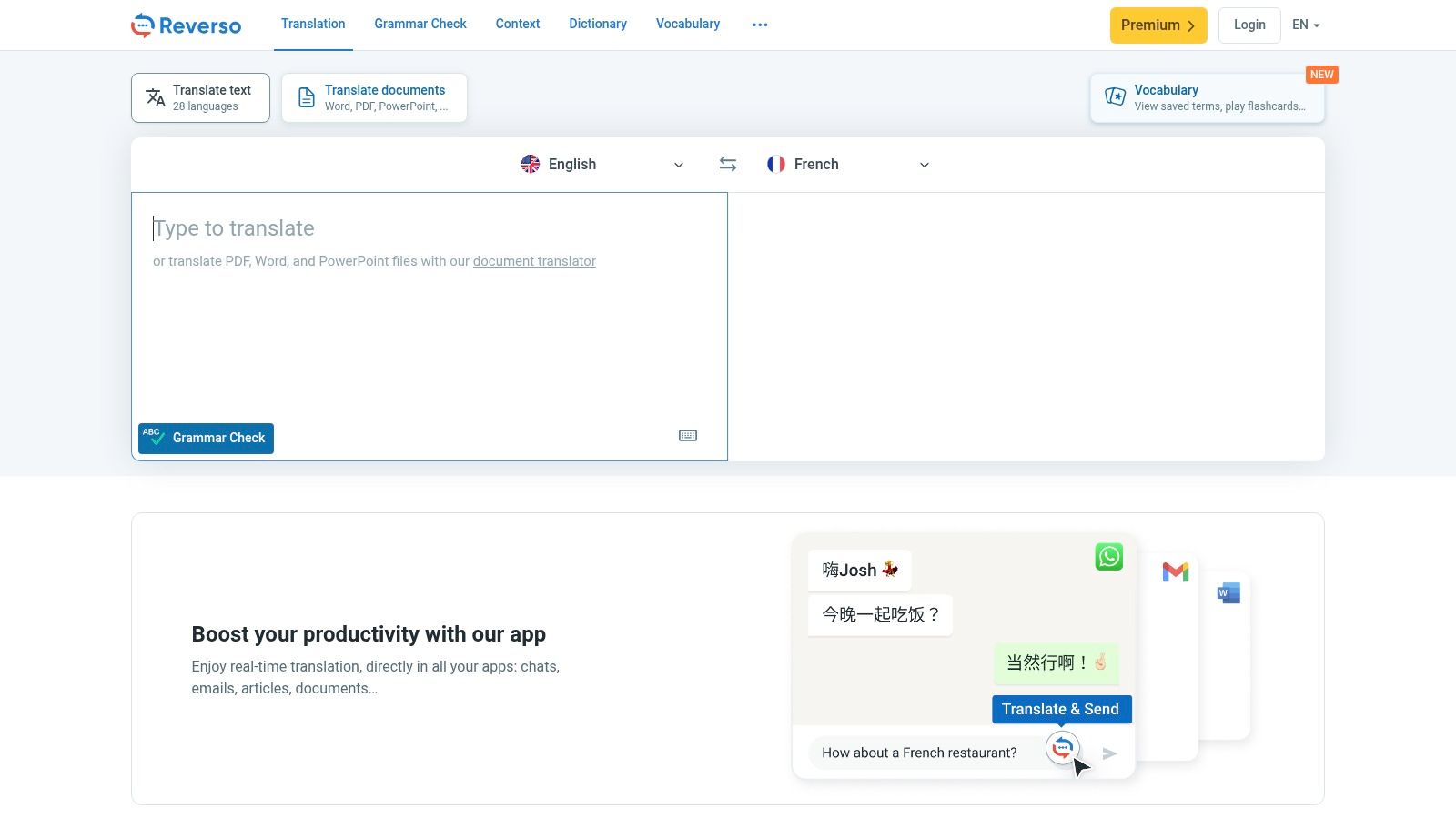
The platform is more than a simple translator; it’s a comprehensive language suite. It includes features like a synonym dictionary, verb conjugation tables, and grammar checkers, which are particularly useful for business professionals and localization managers drafting or reviewing content in a foreign language. The user interface neatly organizes these tools, allowing for a seamless transition between translating a term and exploring its grammatical properties. While the free version is robust, some advanced features and an ad-free experience require a premium subscription.
Key Considerations
| Feature | Analysis |
|---|---|
| Best For | Language learners, writers, and professionals needing contextual accuracy. |
| Pricing | Free with a premium subscription available for advanced features. |
| Pros | Excellent contextual examples, integrated learning tools (conjugation, synonyms), and useful for understanding nuance. |
| Cons | Smaller language selection than major competitors; offline access is limited in the free version. |
Website: https://www.reverso.net
7. Yandex.Translate
Yandex.Translate emerges as a strong contender in the translation space, particularly for users communicating in languages prevalent in Russia and its neighboring countries. This app for language translation supports over 90 languages and provides a comprehensive suite of features, including text, voice, and even image-based translations through your device’s camera. Its clean, fast interface makes it a highly accessible tool for travelers and professionals alike who need reliable translations on the fly.
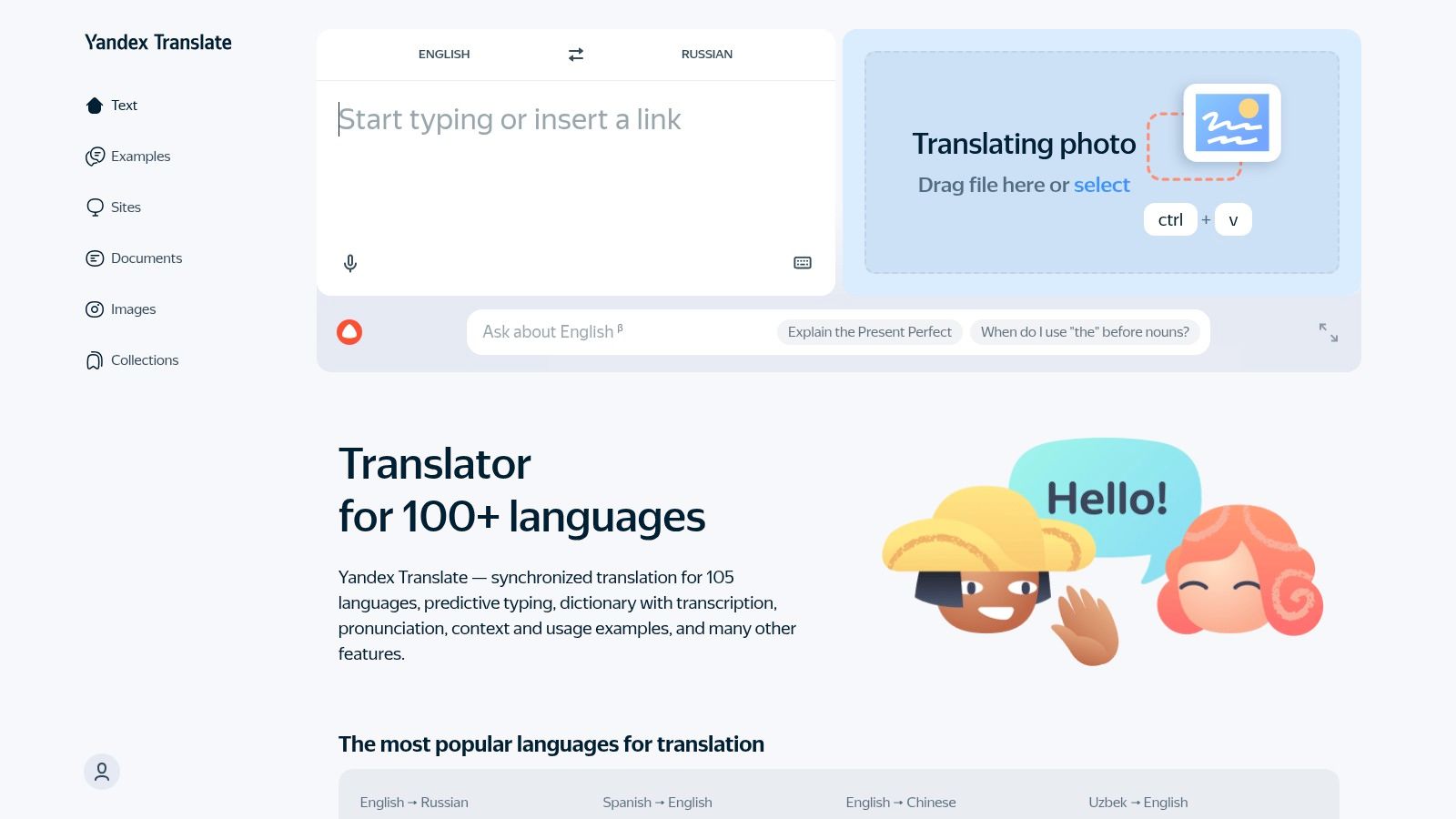
The platform’s standout capability is its powerful neural machine translation technology, which delivers surprisingly nuanced and context-aware results for its core languages. Like its competitors, it offers a valuable offline mode, allowing users to download language packs for use without an internet connection. While its integrations with other services are not as extensive as Google’s, Yandex.Translate excels as a standalone solution with a strong focus on a user-friendly experience and solid performance, especially for Eurasian languages.
Key Considerations
| Feature | Analysis |
|---|---|
| Best For | Travelers and professionals needing strong support for Russian and other Eastern European languages. |
| Pricing | Free for consumer use. |
| Pros | Excellent performance for its specialized languages, versatile translation inputs, and a fast, intuitive interface. |
| Cons | Translation accuracy can be less reliable for less common language pairs, and it lacks deep third-party integrations. |
Website: https://translate.yandex.com
8. Linguee
Linguee operates less as a direct app for language translation and more as a sophisticated, context-aware bilingual dictionary. Instead of providing instant machine translation for sentences, it functions as a search engine that scours millions of professionally translated bilingual texts. This approach is invaluable for users who need to understand not just the meaning of a word, but how it is used in real-world contexts, making it a go-to resource for translators, language students, and professionals drafting precise documents.
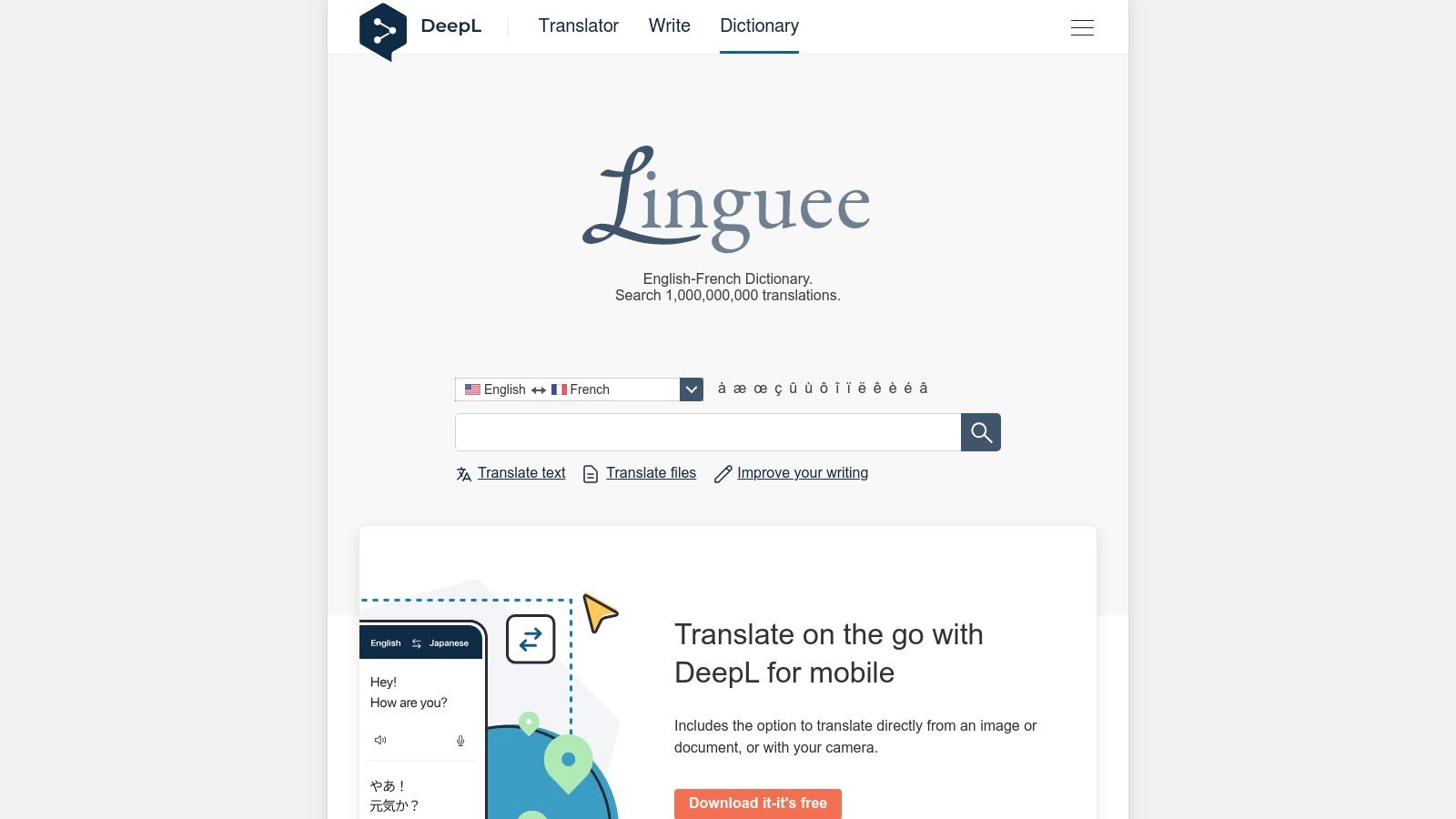
The platform’s key differentiator is its side-by-side display of source text and its translation, pulled from reliable sources like EU documents and patent specifications. This allows users to see idioms, technical terms, and nuanced phrases used naturally. While it doesn’t offer real-time conversation translation, its offline dictionary app is excellent for in-depth word lookups without an internet connection. Linguee is the perfect complementary tool to a standard translation app, bridging the gap between automated output and human-level understanding of specific terminology.
Key Considerations
| Feature | Analysis |
|---|---|
| Best For | Professional translators, language learners, and anyone needing contextual accuracy for specific words or phrases. |
| Pricing | Completely free to use. |
| Pros | Provides real-world examples from a massive database, excellent for understanding nuance and context, and offers a free offline dictionary. |
| Cons | Does not perform real-time sentence or conversation translation; its utility is limited to word and phrase lookups within set language pairs. |
Website: https://www.linguee.com
9. Apple Translate
For users embedded in the Apple ecosystem, Apple Translate provides a seamless and secure app for language translation built directly into iOS, iPadOS, and macOS. Its primary strength is its native integration, offering a clean, intuitive interface that feels familiar to any iPhone or iPad user. The app excels at on-the-spot text and voice translations, featuring a user-friendly conversation mode that facilitates real-time dialogues.
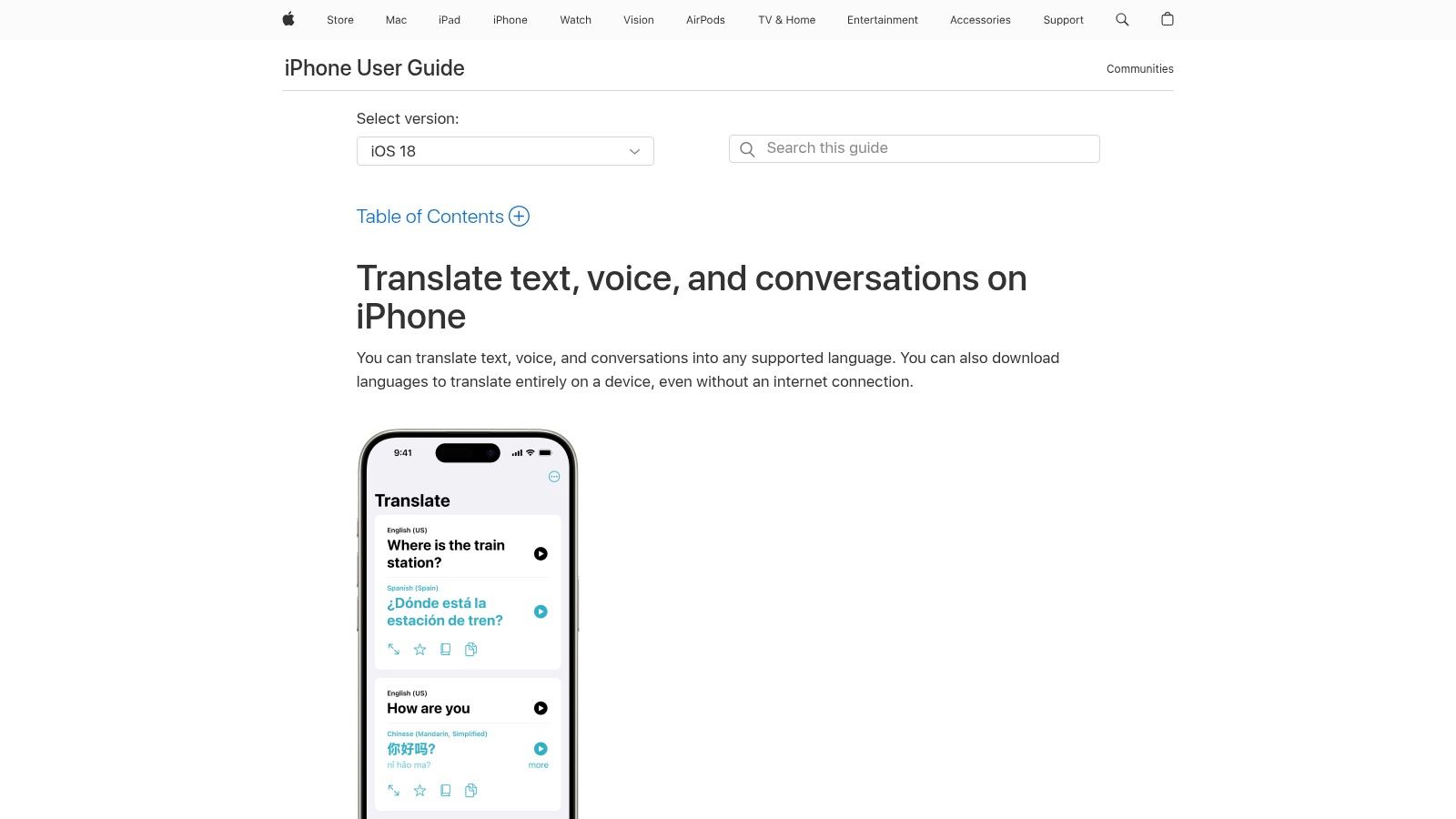
What sets Apple Translate apart is its strong emphasis on privacy, processing many translations on-device without sending data to the cloud. This makes it a trustworthy choice for personal or sensitive conversations. Its offline mode, available for all supported languages, is another significant advantage for travelers. While its language library is smaller than competitors, its performance and integration are key for Apple loyalists. For businesses considering how to offer native language support, this tool highlights the importance of integrated solutions for providing multilingual customer service.
Key Considerations
| Feature | Analysis |
|---|---|
| Best For | Apple users needing quick, private, and well-integrated translation for travel and daily conversations. |
| Pricing | Free and included with Apple’s operating systems. |
| Pros | Flawless iOS integration, strong privacy focus with on-device processing, and a very easy-to-use interface. |
| Cons | Limited to Apple devices and supports significantly fewer languages than major competitors like Google or Microsoft. |
Website: https://support.apple.com/en-us/HT211671
10. Speak & Translate
Speak & Translate is an iOS-exclusive app for language translation designed primarily for voice-to-voice communication. Its standout feature is the real-time conversation mode, which captures spoken words and provides an instant audio translation, making it ideal for travelers navigating foreign countries. With support for over 100 languages for text and a significant number for voice, it covers most common communication needs.

The platform’s strength lies in its clean, intuitive interface that simplifies the process of starting a conversation or translating text. The inclusion of an offline mode for selected language pairs is a critical benefit for users without consistent internet access. While it excels at conversational translation, businesses might consider how such tools fit into a broader support strategy, such as setting up a multilingual service desk. The app’s full feature set, including unlimited translations and the offline mode, is locked behind a subscription model.
Key Considerations
| Feature | Analysis |
|---|---|
| Best For | iOS users, travelers, and real-time voice conversations. |
| Pricing | Freemium with a required subscription for full features. |
| Pros | Excellent voice recognition, intuitive user interface, and offline capabilities. |
| Cons | Only available on iOS, and core features require a paid subscription. |
Website: https://apps.apple.com/us/app/speak-translate-translator/id804641004
11. Maestra AI
Maestra AI positions itself as a specialized localization platform, moving beyond simple text translation into the realm of multimedia content. This AI-powered tool is designed for professionals who need to translate and adapt video and audio content, offering features like auto-subtitling, AI dubbing, and voiceovers. It is an excellent app for language translation when the project involves localizing marketing videos, e-learning courses, or internal corporate communications for a global audience.
The platform stands out by providing a comprehensive suite of tools within a single, collaborative environment. Users can generate transcripts, translate them, and then create AI-generated voiceovers using a diverse library of voices, all in over 125 languages. While it’s not a free tool like some consumer-focused apps, its project-based pricing and subscription models offer a scalable solution for businesses and content creators needing high-quality, efficient localization without the high cost of traditional studio production.
Key Considerations
| Feature | Analysis |
|---|---|
| Best For | Video/audio localization, AI dubbing, and generating subtitles for professional use. |
| Pricing | Free trial available; paid plans are subscription-based or per-project. |
| Pros | All-in-one platform for transcription, translation, and voiceover; offers API integration and collaboration. |
| Cons | Can be overkill for simple text translation; pricing model is not suited for casual, one-off use. |
Website: https://maestra.ai
12. Pimsleur
Pimsleur takes a different approach, positioning itself not as an instant app for language translation, but as a deep language learning tool. Its methodology is entirely audio-based, focusing on teaching users to speak and understand a new language through conversational lessons. This makes it an ideal choice for auditory learners or professionals who want to build foundational fluency for long-term international assignments, rather than needing an immediate on-the-spot translation.
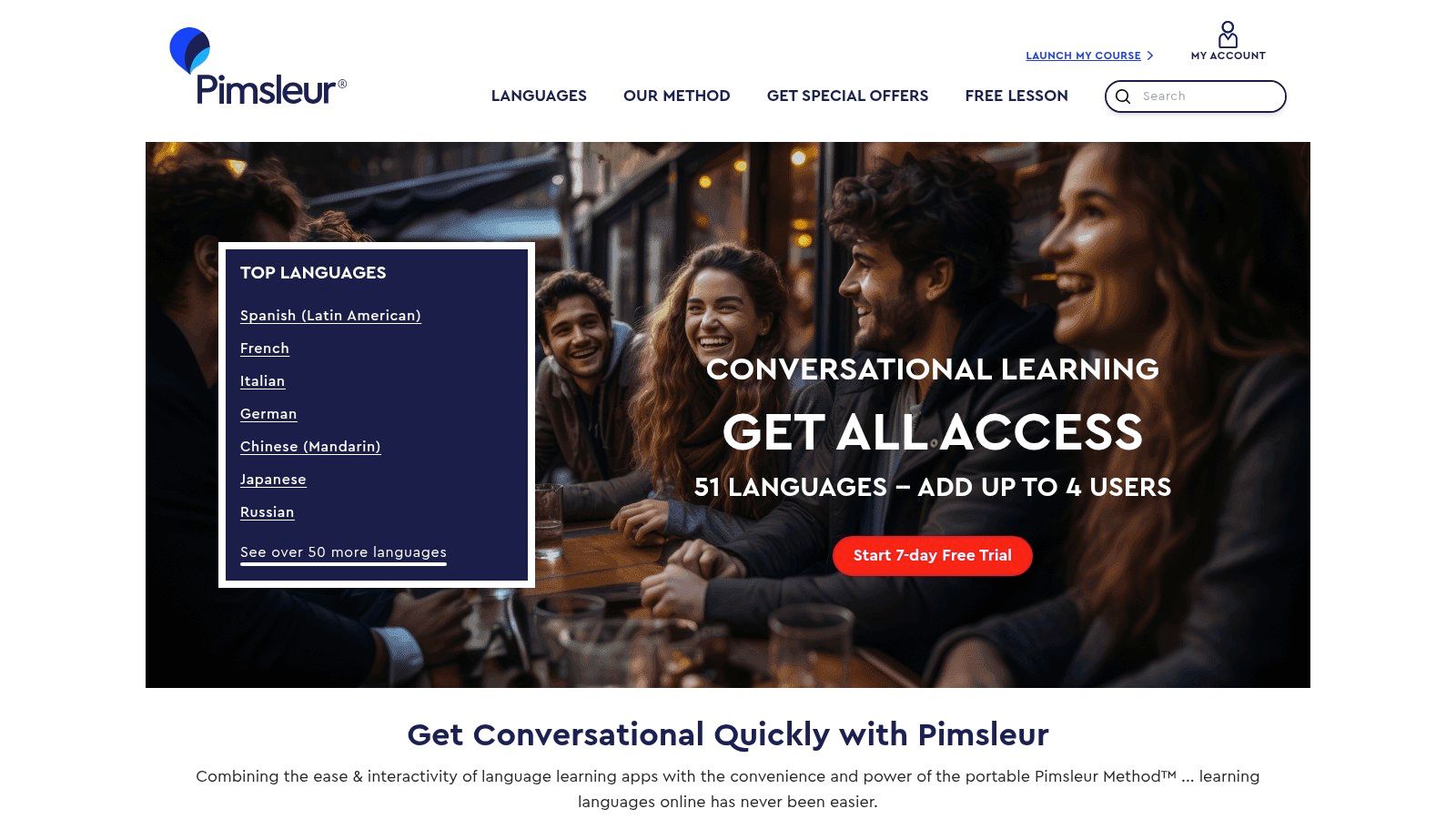
The platform stands out by building practical conversational skills from the ground up, a stark contrast to machine translation tools. Lessons are designed to be completed daily and can be downloaded for offline use, perfect for commuting or travel. While it doesn’t offer the quick translation features of others on this list, it provides a powerful way to internalize a language, which is a more sustainable solution for anyone regularly interacting with global teams or clients in a specific region.
Key Considerations
| Feature | Analysis |
|---|---|
| Best For | Auditory learners and professionals committed to learning a new language for long-term use. |
| Pricing | Subscription-based; no free version is available, though a free trial is offered. |
| Pros | Proven audio-based learning method, high-quality content, and offline lesson access. |
| Cons | Not a translation tool for immediate needs; subscription cost can be a barrier. |
Website: https://www.pimsleur.com
Top 12 Language Translation Apps Features Comparison
| Product | Core Features / Characteristics | User Experience / Quality ★ | Value Proposition 💰 | Target Audience 👥 | Unique Selling Points ✨ |
|---|---|---|---|---|---|
| 🏆 resolution Reichert Network Solutions GmbH | AI-powered, real-time Jira Service Management translation; bilingual & invisible modes | ★★★★★ (Enterprise-grade, secure) | Affordable subscription; no external translators needed | ITSM teams, SaaS vendors, enterprises | Deep JSM integration; language queues & JQL; translation editor |
| Google Translate | Text, voice, image translations; offline mode | ★★★☆☆ (Varied accuracy) | Free | General users, travelers | Wide language support; Google ecosystem integration |
| Microsoft Translator | Text, voice, image; Office & Teams integration | ★★★★☆ (Reliable) | Free with Microsoft account | Business users, MS Office users | Group conversation; Microsoft product integration |
| DeepL Translator | Neural network translations; document & tone options | ★★★★☆ (High accuracy) | Freemium; premium features subscription | Professionals, translators | Natural sounding European language translations |
| iTranslate | Text, voice, image; offline mode in premium | ★★★☆☆ (Mobile-friendly) | Freemium; subscription for full features | Travelers, mobile users | Voice-to-voice; website translation |
| Reverso | Contextual translations; grammar & conjugation tools | ★★★☆☆ (Learner-focused) | Free | Language learners | Context examples; grammar help |
| Yandex.Translate | Text, voice, image; offline mode | ★★★☆☆ (User-friendly) | Free | Russian-speaking region users | Supports regional languages; offline mode |
| Linguee | Bilingual dictionaries with contextual examples | ★★★☆☆ (Context-rich) | Free | Language learners, translators | Extensive example database; offline dictionary |
| Apple Translate | Text, voice translations; offline & conversation mode | ★★★☆☆ (Privacy-focused) | Free | Apple device users | iOS native; offline for all supported languages |
| Speak & Translate | Voice recognition; offline mode | ★★★☆☆ (Traveler friendly) | Freemium; subscription for full features | Travelers, iOS users | Real-time voice conversations; offline mode |
| Maestra AI | Real-time translation; live captioning & AI dubbing | ★★★★☆ (Professional use) | Paid (per project/subscription) | Localization pros, event organizers | AI dubbing; 125+ languages; API & collaboration |
| Pimsleur | Audio-based language lessons; offline | ★★★★☆ (High content quality) | Subscription required | Language learners preferring audio | Audio focus; flexible learning |
Choosing Your Voice in a Global Conversation
Navigating the vast landscape of language translation technology can feel overwhelming, but as we’ve explored, the “best” solution is not a one-size-fits-all answer. Your ideal tool hinges entirely on your specific context, workflow, and strategic goals. The journey from a simple text-to-text conversion to a fully integrated multilingual support system is marked by a deliberate choice, one that moves beyond basic functionality to embrace true operational efficiency.
The general-purpose app for language translation has undeniably revolutionized personal communication. For the globetrotting professional or casual tourist, the real-time conversation modes in Google Translate and Microsoft Translator, or the intuitive interface of Apple Translate, are indispensable. They break down immediate barriers and make the world more accessible.
However, for professionals and businesses, the criteria for selection become far more stringent. It’s no longer just about translating a sentence; it’s about preserving nuance, maintaining brand voice, and ensuring data security.
Key Takeaways for Selecting Your Translation Tool
When making your final decision, the choice often boils down to a few critical factors that separate a good tool from the right one for your organization:
- Accuracy and Context: For high-stakes document translation, where precision is paramount, DeepL remains the benchmark. Its neural network excels at understanding and replicating idiomatic expressions and complex sentence structures, making it a favorite among localization managers.
- Integration and Workflow: This is the most crucial consideration for service desks and software vendors. A standalone app creates friction and adds manual steps. An integrated solution like Resolution’s Issue Translation for JSM eliminates this by embedding translation directly within existing platforms like Jira Service Management. This transforms a reactive process into a seamless, proactive part of your support infrastructure.
- Use Case Specificity: Are you translating customer support tickets, localizing a software interface, or preparing legal documents? A customer support agent needs speed and integration, while a marketer using Reverso might prioritize its contextual examples to ensure their copy resonates culturally.
- Learning vs. Translating: It’s important to distinguish between tools for real-time translation and those designed for language acquisition. While many apps on our list offer some learning features, dedicated platforms are superior for structured learning. For those prioritizing dedicated language learning tools over just translation, a valuable resource is the guide to the best English learning apps from SpeakMeeters, which categorizes options by proficiency level.
Final Thoughts on Implementation
Ultimately, selecting an app for language translation is an investment in communication. For our target audience of IT teams, MSPs, and e-commerce brands, this investment pays the highest dividends when it enhances existing systems rather than complicating them. The future of global business communication isn’t about having a separate app open in another tab; it’s about empowering your teams with tools that make language barriers invisible directly within their daily workflows. By choosing wisely, you are not just adopting a new piece of software; you are fundamentally upgrading your ability to connect, support, and succeed in a global marketplace.
Ready to eliminate language barriers in your customer support workflow? Discover how the integrated solutions from resolution Reichert Network Solutions GmbH can embed powerful, secure translation directly into your Jira Service Management environment. See how resolution Reichert Network Solutions GmbH can help your teams communicate effortlessly with users around the world.
